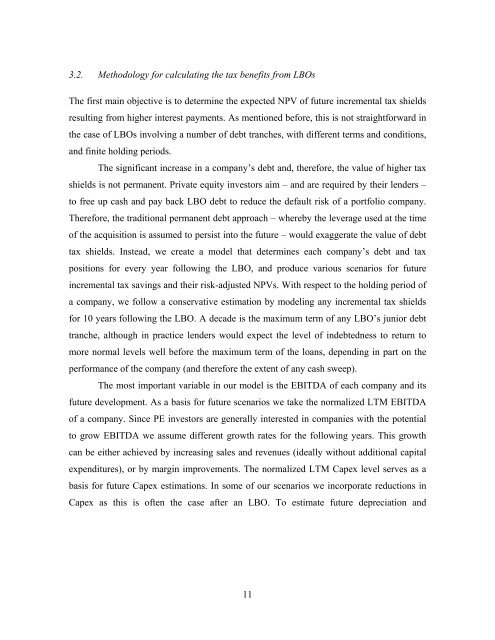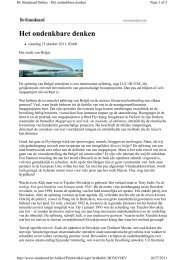Who benefits from the leverage in LBOs? - Said Business School ...
Who benefits from the leverage in LBOs? - Said Business School ...
Who benefits from the leverage in LBOs? - Said Business School ...
Create successful ePaper yourself
Turn your PDF publications into a flip-book with our unique Google optimized e-Paper software.
3.2. Methodology for calculat<strong>in</strong>g <strong>the</strong> tax <strong>benefits</strong> <strong>from</strong> <strong>LBOs</strong><br />
The first ma<strong>in</strong> objective is to determ<strong>in</strong>e <strong>the</strong> expected NPV of future <strong>in</strong>cremental tax shields<br />
result<strong>in</strong>g <strong>from</strong> higher <strong>in</strong>terest payments. As mentioned before, this is not straightforward <strong>in</strong><br />
<strong>the</strong> case of <strong>LBOs</strong> <strong>in</strong>volv<strong>in</strong>g a number of debt tranches, with different terms and conditions,<br />
and f<strong>in</strong>ite hold<strong>in</strong>g periods.<br />
The significant <strong>in</strong>crease <strong>in</strong> a company’s debt and, <strong>the</strong>refore, <strong>the</strong> value of higher tax<br />
shields is not permanent. Private equity <strong>in</strong>vestors aim – and are required by <strong>the</strong>ir lenders –<br />
to free up cash and pay back LBO debt to reduce <strong>the</strong> default risk of a portfolio company.<br />
Therefore, <strong>the</strong> traditional permanent debt approach – whereby <strong>the</strong> <strong>leverage</strong> used at <strong>the</strong> time<br />
of <strong>the</strong> acquisition is assumed to persist <strong>in</strong>to <strong>the</strong> future – would exaggerate <strong>the</strong> value of debt<br />
tax shields. Instead, we create a model that determ<strong>in</strong>es each company’s debt and tax<br />
positions for every year follow<strong>in</strong>g <strong>the</strong> LBO, and produce various scenarios for future<br />
<strong>in</strong>cremental tax sav<strong>in</strong>gs and <strong>the</strong>ir risk-adjusted NPVs. With respect to <strong>the</strong> hold<strong>in</strong>g period of<br />
a company, we follow a conservative estimation by model<strong>in</strong>g any <strong>in</strong>cremental tax shields<br />
for 10 years follow<strong>in</strong>g <strong>the</strong> LBO. A decade is <strong>the</strong> maximum term of any LBO’s junior debt<br />
tranche, although <strong>in</strong> practice lenders would expect <strong>the</strong> level of <strong>in</strong>debtedness to return to<br />
more normal levels well before <strong>the</strong> maximum term of <strong>the</strong> loans, depend<strong>in</strong>g <strong>in</strong> part on <strong>the</strong><br />
performance of <strong>the</strong> company (and <strong>the</strong>refore <strong>the</strong> extent of any cash sweep).<br />
The most important variable <strong>in</strong> our model is <strong>the</strong> EBITDA of each company and its<br />
future development. As a basis for future scenarios we take <strong>the</strong> normalized LTM EBITDA<br />
of a company. S<strong>in</strong>ce PE <strong>in</strong>vestors are generally <strong>in</strong>terested <strong>in</strong> companies with <strong>the</strong> potential<br />
to grow EBITDA we assume different growth rates for <strong>the</strong> follow<strong>in</strong>g years. This growth<br />
can be ei<strong>the</strong>r achieved by <strong>in</strong>creas<strong>in</strong>g sales and revenues (ideally without additional capital<br />
expenditures), or by marg<strong>in</strong> improvements. The normalized LTM Capex level serves as a<br />
basis for future Capex estimations. In some of our scenarios we <strong>in</strong>corporate reductions <strong>in</strong><br />
Capex as this is often <strong>the</strong> case after an LBO. To estimate future depreciation and<br />
11
















